|
|
|

|
|
2020 (vol. 20)
|
|
The biosignature of sparite permits the distinction between gravitational cement and endostromatolites
Bruno R.C. GRANIER
| HTML  | PDF
| PDF  [2,953 KB]
| DOI: 10.2110/carnets.2020.2020 [2,953 KB]
| DOI: 10.2110/carnets.2020.2020
|
|
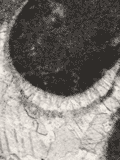 Abstract: Following
a brief summary of some fundamentals in carbonate sedimentology (sedimentary petrography) that highlights the
significance of organic matter, some examples of biocrystals in carbonate
grains/particles, such as bioclasts or ooids, are provided as
an introductory chapter to a discussion on gravitational cements versus
endostromatolites. The gravitational cements, either marine (fibrous) or
continental (dog-tooth), are made of hyaline (i.e., translucent)
sparitic crystals whereas endostromatolites are made of colored sparitic
crystals and/or micrite. Gravitational cements forms in the vadose zone
whereas endostromatolites grow in small rock cavities in the
marine phreatic zone. As such the latter can grow centripetally in all directions (not
only downward). Abstract: Following
a brief summary of some fundamentals in carbonate sedimentology (sedimentary petrography) that highlights the
significance of organic matter, some examples of biocrystals in carbonate
grains/particles, such as bioclasts or ooids, are provided as
an introductory chapter to a discussion on gravitational cements versus
endostromatolites. The gravitational cements, either marine (fibrous) or
continental (dog-tooth), are made of hyaline (i.e., translucent)
sparitic crystals whereas endostromatolites are made of colored sparitic
crystals and/or micrite. Gravitational cements forms in the vadose zone
whereas endostromatolites grow in small rock cavities in the
marine phreatic zone. As such the latter can grow centripetally in all directions (not
only downward).
|
|
Carnets Geol., vol. 20, no. 20, p. 407-419
Online since November 20, 2020
|
|
The Mesozoic scleractinian genus Adelocoenia (Stylinidae) and its Jurassic species
Bernard LATHUILIÈRE, Rosemarie C. BARON-SZABO, Sylvain CHARBONNIER & Jean-Michel PACAUD
| HTML  | PDF
| PDF  [4,677 KB]
| DOI: 10.2110/carnets.2020.2019 [4,677 KB]
| DOI: 10.2110/carnets.2020.2019
|
|
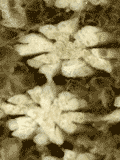 Abstract: The genus Adelocoenia Orbigny,
1849, is revised and a neotype is
designated for its type species Astrea
castellum Michelin, 1844. For various reasons that lie in the
taxonomic history of scleractinian corals, it has become a difficult task to
reliably assign Mesozoic corals having the combined features of plocoid
corallite integration and the absence of a columella. Therefore, many such
genera are in need of revision, one of which is Adelocoenia. In addition to the revision of the type species,
Jurassic species grouped within Adelocoenia
are revised using type material when it was possible. Many new synonymies are
proposed based mainly on characters such as symmetry and dimensions of skeletal
features. Another consequence is that most species previously grouped with Pseudocoenia
Orbigny are transferred to Adelocoenia.
Furthermore, we present a clarified view of the paleogeographical and
stratigraphical distributional patterns of the genus Adelocoenia, according to which Adelocoenia
had its first appearance during the Early Jurassic, represented by a single
specimen known from the Sinemurian of France. Subsequently, this genus had a
significant increase in both distribution and diversity during the Middle
Jurassic. The pinnacle of its success followed in the Late Jurassic during which
Adelocoenia had its greatest
morphological disparity and taxonomical diversity, and its largest geographical
distribution. The genus survived in the Cretaceous record. Throughout its
history, Adelocoenia predominantly
occurred in inner platform environments that were located in low latitudes. Abstract: The genus Adelocoenia Orbigny,
1849, is revised and a neotype is
designated for its type species Astrea
castellum Michelin, 1844. For various reasons that lie in the
taxonomic history of scleractinian corals, it has become a difficult task to
reliably assign Mesozoic corals having the combined features of plocoid
corallite integration and the absence of a columella. Therefore, many such
genera are in need of revision, one of which is Adelocoenia. In addition to the revision of the type species,
Jurassic species grouped within Adelocoenia
are revised using type material when it was possible. Many new synonymies are
proposed based mainly on characters such as symmetry and dimensions of skeletal
features. Another consequence is that most species previously grouped with Pseudocoenia
Orbigny are transferred to Adelocoenia.
Furthermore, we present a clarified view of the paleogeographical and
stratigraphical distributional patterns of the genus Adelocoenia, according to which Adelocoenia
had its first appearance during the Early Jurassic, represented by a single
specimen known from the Sinemurian of France. Subsequently, this genus had a
significant increase in both distribution and diversity during the Middle
Jurassic. The pinnacle of its success followed in the Late Jurassic during which
Adelocoenia had its greatest
morphological disparity and taxonomical diversity, and its largest geographical
distribution. The genus survived in the Cretaceous record. Throughout its
history, Adelocoenia predominantly
occurred in inner platform environments that were located in low latitudes.
|
|
Carnets Geol., vol. 20, no. 19, p. 367-406
Online since November 11, 2020
|
|
Exceptionally well-preserved silicified hippuritid rudist bivalves from the lower Maastrichtian of Puerto Rico
Simon F. MITCHELL
| HTML  | PDF
| PDF  [5,339 KB]
| DOI: 10.2110/carnets.2020.2018 [5,339 KB]
| DOI: 10.2110/carnets.2020.2018
|
|
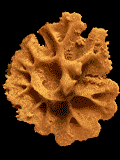 Abstract: Exceptionally
well-preserved (silicified) hippuritid rudists occur in the El Rayo Formation (lower
Maastrichtian) of south-western Puerto Rico. Three species belonging to three
different genera are present: Caribbea
muellerreidi (Vermunt), Laluzia
peruviana (Gerth) and Parastroma
guitarti (Palmer). Acid digestion of the limestones has resulted in a
collection with numerous three-dimensional left and right valves many with the
preservation of the minute details of the pore system. The morphological
features of each species are described, and many features are illustrated for
the first time. The new material, coupled with descriptions from other studies,
demonstrates that six genera of endemic hippuritids evolved in two separate
radiations in the New World: an older radiation of forms that had pallial canals
in their left valves (Barrettia, Whitfieldiella
and Parastroma) and a younger
radiation of forms lacking pallial canals in their left valves (Laluzia, Caribbea and Praebarrettia).
The exquisite preservation also reveals that in these endemic New World
hippuritids the sockets for the teeth consisted of slots into which ribs on the
teeth fitted; this contrasts with Old World hippuritids that have true sockets
formed from upfolds of the tabulae for the teeth. The distinctive morphology of
the tooth sockets is here used to define a monophyletic subfamily for which the
name Barrettiinae Chubb is available. Abstract: Exceptionally
well-preserved (silicified) hippuritid rudists occur in the El Rayo Formation (lower
Maastrichtian) of south-western Puerto Rico. Three species belonging to three
different genera are present: Caribbea
muellerreidi (Vermunt), Laluzia
peruviana (Gerth) and Parastroma
guitarti (Palmer). Acid digestion of the limestones has resulted in a
collection with numerous three-dimensional left and right valves many with the
preservation of the minute details of the pore system. The morphological
features of each species are described, and many features are illustrated for
the first time. The new material, coupled with descriptions from other studies,
demonstrates that six genera of endemic hippuritids evolved in two separate
radiations in the New World: an older radiation of forms that had pallial canals
in their left valves (Barrettia, Whitfieldiella
and Parastroma) and a younger
radiation of forms lacking pallial canals in their left valves (Laluzia, Caribbea and Praebarrettia).
The exquisite preservation also reveals that in these endemic New World
hippuritids the sockets for the teeth consisted of slots into which ribs on the
teeth fitted; this contrasts with Old World hippuritids that have true sockets
formed from upfolds of the tabulae for the teeth. The distinctive morphology of
the tooth sockets is here used to define a monophyletic subfamily for which the
name Barrettiinae Chubb is available.
|
|
Carnets Geol., vol. 20, no. 18, p. 333-366
Online since November 11, 2020
|
|
Messinian Lago-Mare ostracods from Tunisia
Rim TEMANI, Francesco SCIUTO & Hayet K. AMMAR
| HTML  | PDF
| PDF  [1,121 KB]
| DOI: 10.2110/carnets.2020.2017 [1,121 KB]
| DOI: 10.2110/carnets.2020.2017
|
|
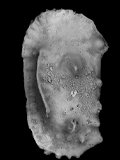 Abstract: Micropalaeontological analyses were performed on two stratigraphical
sections sampled in upper Messinian deposits outcropping in eastern Tunisia,
allowing us to identify some sedimentary levels with high concentrations of
fresh or brackish water ostracods, which can be referred to the Lago-Mare fauna. Some of these species can be considered
Paratethysian, or rather as species that spread in the Mediterranean area starting from
the Paratethys areas, while others show Paratethysian affinity. The Lago-Mare
fauna is little known in the south Mediterranean regions and the
present article provides new data on its geographic distribution. Abstract: Micropalaeontological analyses were performed on two stratigraphical
sections sampled in upper Messinian deposits outcropping in eastern Tunisia,
allowing us to identify some sedimentary levels with high concentrations of
fresh or brackish water ostracods, which can be referred to the Lago-Mare fauna. Some of these species can be considered
Paratethysian, or rather as species that spread in the Mediterranean area starting from
the Paratethys areas, while others show Paratethysian affinity. The Lago-Mare
fauna is little known in the south Mediterranean regions and the
present article provides new data on its geographic distribution.
Of the two sections sampled,
the first one, the Wadi El Kebir section, is located in the south eastern part of the Cape Bon Peninsula and
shows horizons dominated by Cyprideis
agrigentina and Cyprideis ex
C. torosa group; the second one, the Salakta section, is located in the
Sahel region and shows a level with a very rich Lago-Mare ostracod fauna
consisting essentially of Amnicythere
propinqua, Mediocytherideis punctata,
and Ilyocypris gibba.
|
|
Carnets Geol., vol. 20, no. 17, p. 315-331
Online since October 14, 2020
|
|
First authentic record of the freshwater turtle Mauremys from the Upper Pliocene of Italy,
with a new occurrence of the rarely reported ichnotaxon Thatchtelithichnus holmani
Alberto COLLARETA, Simone CASATI, Marco A.L. ZUFFI & Andrea DI CENCIO
| HTML  | PDF
| PDF  [1,078 KB]
| DOI: 10.2110/carnets.2020.2016 [1,078 KB]
| DOI: 10.2110/carnets.2020.2016
|
|
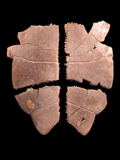 Abstract: Nowadays, the living species of the terrapin genus Mauremys (Testudinoidea:
Geoemydidae) are mostly found in eastern Asia, but three of them inhabit the Western Palearctic ecozone.
In Italy, occurrences of living individuals of Mauremys are interpreted
as records of alien species; however, a growing fossil record demonstrates that this
genus has inhabited Italy as recently
as the Late Pleistocene. We report on a new fossil specimen of Mauremys
from the Upper Pliocene (Piacenzian) marginal-marine deposits of Tuscany
(central Italy). This find, consisting of a partial plastron and a loose neural,
represents the second authentic report of Mauremys from the Italian
Pliocene, as well as the first one from the Piacenzian of Italy. Therefore, it
is a significant fossil that fills a gap in the chronostratigraphic distribution
of Italian fossil Mauremys, helping – together with the Lower Pliocene
holotype of Mauremys portisi – to bridge the rich Miocene and
Pleistocene segments of this record. Moreover, two unusual scars observed on the
external surface of the studied plastron are here referred to the ichnospecies Thatchtelithichnus
holmani. These traces represent one of the few records worldwide of this
rarely identified ichnospecies, as well as its geologically youngest published
occurrence. Hypotheses regarding the origin of the Thatchtelithichnus
traces are reevaluated, and an origin as attachment scars of aquatic
ectoparasites (possibly ticks, leeches, or flukes) is reaffirmed as
probable in cases of traces occurring on the exterior of the plastral bones of turtles. Abstract: Nowadays, the living species of the terrapin genus Mauremys (Testudinoidea:
Geoemydidae) are mostly found in eastern Asia, but three of them inhabit the Western Palearctic ecozone.
In Italy, occurrences of living individuals of Mauremys are interpreted
as records of alien species; however, a growing fossil record demonstrates that this
genus has inhabited Italy as recently
as the Late Pleistocene. We report on a new fossil specimen of Mauremys
from the Upper Pliocene (Piacenzian) marginal-marine deposits of Tuscany
(central Italy). This find, consisting of a partial plastron and a loose neural,
represents the second authentic report of Mauremys from the Italian
Pliocene, as well as the first one from the Piacenzian of Italy. Therefore, it
is a significant fossil that fills a gap in the chronostratigraphic distribution
of Italian fossil Mauremys, helping – together with the Lower Pliocene
holotype of Mauremys portisi – to bridge the rich Miocene and
Pleistocene segments of this record. Moreover, two unusual scars observed on the
external surface of the studied plastron are here referred to the ichnospecies Thatchtelithichnus
holmani. These traces represent one of the few records worldwide of this
rarely identified ichnospecies, as well as its geologically youngest published
occurrence. Hypotheses regarding the origin of the Thatchtelithichnus
traces are reevaluated, and an origin as attachment scars of aquatic
ectoparasites (possibly ticks, leeches, or flukes) is reaffirmed as
probable in cases of traces occurring on the exterior of the plastral bones of turtles.
|
|
Carnets Geol., vol. 20, no. 16, p. 301-313
Online since October 14, 2020
|
|
Additional data on post-Paleozoic sea-lilies (Crinoidea, Echinodermata) from the Outer Carpathians of the Czech Republic and Poland
Mariusz A. SALAMON, Miroslav BUBÍK, Bruno FERRÉ, Andrzej SZYDŁO, Piotr NESCIERUK, Bartosz J. PŁACHNO, Tomasz BRACHANIEC & Karolina PASZCZA
| HTML  | PDF
| PDF  [1,067 KB]
| DOI: 10.2110/carnets.2020.2015 [1,067 KB]
| DOI: 10.2110/carnets.2020.2015
|
|
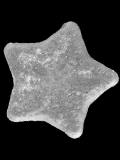 Abstract: Jurassic (Tithonian) and Lower Cretaceous (Berriasian/Valanginian-Hauterivian)
strata of the Vendryně and Cieszyn Limestones formations in the Czech
Republic and Poland are locally rich in crinoid remains, consisting of whole
cups, isolated cup elements, brachial plates, columnals and pluricolumnals,
cirrals, and holdfasts. They are assigned to isocrinids (Isocrinida: Isocrinus
cf. amblyscalaris, Isocrinida
indet.), cyrtocrinids (Cyrtocrinida: Eugeniacrinites sp.,
Phyllocrinus sp., Gammarocrinites sp.,
Hemicrinus tithonicus, Plicatocrinus
hexagonus, Cyrtocrinida indet.), millericrinids (Millericrinida:
Millericrinida indet.), and thiolliericrinids (Comatulida, Thiolliericrinidae:
Thiolliericrinidae gen. et sp. indet.). Late Cretaceous (Maastrichtian) and
Paleogene (Paleocene-Oligocene) crinoids from the Subsilesian Unit are recorded
as individual remains belonging to: Isocrinida indet., Cyrtocrinida indet.,
bourgueticrinids (Comatulida, Bourgueticrinina: Bourgueticrinina fam. et gen.
indet.) and roveacrinids (Roveacrinida, Roveacrinidae gen. et sp. indet.).
Roveacrinids were retrieved only from Maastrichtian samples. Despite the
conclusions previously presented that isocrinids of the Outer Flysch Carpathians
dominated around the Jurassic-Cretaceous boundary due to the very shallow
sedimentary environment of these strata, we can now conclude that they were
common and associated with cyrtocrinids in all types of environments. It is also
worth mentioning that cyrtocrinids and isocrinids occur in Paleogene sediments
that were deposited in extremely shallow environments. On the other hand, many
literature data suggested that Cretaceous (by mid-Cretaceous) isocrinids
migrated to deep-water areas, as a response to an increase in the number of
predators during the so-called Mesozoic marine revolution. Abstract: Jurassic (Tithonian) and Lower Cretaceous (Berriasian/Valanginian-Hauterivian)
strata of the Vendryně and Cieszyn Limestones formations in the Czech
Republic and Poland are locally rich in crinoid remains, consisting of whole
cups, isolated cup elements, brachial plates, columnals and pluricolumnals,
cirrals, and holdfasts. They are assigned to isocrinids (Isocrinida: Isocrinus
cf. amblyscalaris, Isocrinida
indet.), cyrtocrinids (Cyrtocrinida: Eugeniacrinites sp.,
Phyllocrinus sp., Gammarocrinites sp.,
Hemicrinus tithonicus, Plicatocrinus
hexagonus, Cyrtocrinida indet.), millericrinids (Millericrinida:
Millericrinida indet.), and thiolliericrinids (Comatulida, Thiolliericrinidae:
Thiolliericrinidae gen. et sp. indet.). Late Cretaceous (Maastrichtian) and
Paleogene (Paleocene-Oligocene) crinoids from the Subsilesian Unit are recorded
as individual remains belonging to: Isocrinida indet., Cyrtocrinida indet.,
bourgueticrinids (Comatulida, Bourgueticrinina: Bourgueticrinina fam. et gen.
indet.) and roveacrinids (Roveacrinida, Roveacrinidae gen. et sp. indet.).
Roveacrinids were retrieved only from Maastrichtian samples. Despite the
conclusions previously presented that isocrinids of the Outer Flysch Carpathians
dominated around the Jurassic-Cretaceous boundary due to the very shallow
sedimentary environment of these strata, we can now conclude that they were
common and associated with cyrtocrinids in all types of environments. It is also
worth mentioning that cyrtocrinids and isocrinids occur in Paleogene sediments
that were deposited in extremely shallow environments. On the other hand, many
literature data suggested that Cretaceous (by mid-Cretaceous) isocrinids
migrated to deep-water areas, as a response to an increase in the number of
predators during the so-called Mesozoic marine revolution.
|
|
Carnets Geol., vol. 20, no. 15, p. 283-299
Online since October 14, 2020
|
|
Lectotype designation for Orbitolinopsis flandrini Moullade, 1960 (Foraminifera): The missing piece of a taxonomic puzzle
Felix SCHLAGINTWEIT, Ioan I. BUCUR & François LE COZE
| HTML  | PDF
| PDF  [1,370 KB]
| DOI: 10.2110/carnets.2020.2014 [1,370 KB]
| DOI: 10.2110/carnets.2020.2014
|
|
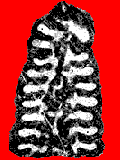 Abstract: Orbitolinopsis
flandrini Moullade, 1960, was described from Lower Cretaceous Urgonian
limestones of southeastern France without the designation of a holotype. It represents
a valid taxon since the selection of a holotype is only obligatory for taxa
established after 1999 (ICZN, 4th edition, article 72.3). Today the
original description is considered to be a mixture of several taxa belonging to Orbitolinopsis Henson,
1948/Cribellopsis Arnaud-Vanneau,
1980 (transverse sections with
cupules/septules in the central zone) and Drevennia
Arnaud-Vanneau, 1980 (axial sections with an axial "columella-like"
column). The short and in any case insufficient original description of O.
flandrini, however, stressed the presence of a columellar-like central test
as the main characteristic feature. In fact, the majority of the (sub)axial
sections showing an axial column (lacking in Orbitolinopsis)
are considered to belong to Drevennia
(Family Pfenderinidae). Therefore, the new combination Drevennia flandrini (Moullade,
1960) is proposed and a
lectotype herein designated from the original illustrations. Drevennia
ecougensis, the type-species of the genus, is found to be a subjective
junior synonym of the latter. New finds from Serbia and Spain extend the
stratigraphic range of D. flandrini,
from the upper Berriasian to the lowermost upper Aptian. The first occurrences
of Drevennia, Dobrogelina Neagu, 1979, Pfenderina Henson,
1948, and Moulladella Bucur & Schlagintweit,
2018, in the upper Berriasian give evidence for an adaptive radiation of the
Pfenderinidae during the time reported and from other, mostly complex larger
benthic foraminifera (e.g., Orbitolinidae). Abstract: Orbitolinopsis
flandrini Moullade, 1960, was described from Lower Cretaceous Urgonian
limestones of southeastern France without the designation of a holotype. It represents
a valid taxon since the selection of a holotype is only obligatory for taxa
established after 1999 (ICZN, 4th edition, article 72.3). Today the
original description is considered to be a mixture of several taxa belonging to Orbitolinopsis Henson,
1948/Cribellopsis Arnaud-Vanneau,
1980 (transverse sections with
cupules/septules in the central zone) and Drevennia
Arnaud-Vanneau, 1980 (axial sections with an axial "columella-like"
column). The short and in any case insufficient original description of O.
flandrini, however, stressed the presence of a columellar-like central test
as the main characteristic feature. In fact, the majority of the (sub)axial
sections showing an axial column (lacking in Orbitolinopsis)
are considered to belong to Drevennia
(Family Pfenderinidae). Therefore, the new combination Drevennia flandrini (Moullade,
1960) is proposed and a
lectotype herein designated from the original illustrations. Drevennia
ecougensis, the type-species of the genus, is found to be a subjective
junior synonym of the latter. New finds from Serbia and Spain extend the
stratigraphic range of D. flandrini,
from the upper Berriasian to the lowermost upper Aptian. The first occurrences
of Drevennia, Dobrogelina Neagu, 1979, Pfenderina Henson,
1948, and Moulladella Bucur & Schlagintweit,
2018, in the upper Berriasian give evidence for an adaptive radiation of the
Pfenderinidae during the time reported and from other, mostly complex larger
benthic foraminifera (e.g., Orbitolinidae).
|
|
Carnets Geol., vol. 20, no. 14, p. 273-282
Online since September 21, 2020
|
|
Stratigraphic and taxonomic considerations on the Late Cretaceous rudist fauna of Aksai Chin (Western Tibet, China) from the De Filippi Collection
Jingeng SHA, Simone FABBI, Riccardo CESTARI & Lorenzo CONSORTI
| HTML  | PDF
| PDF  [3,300 KB]
| DOI: 10.2110/carnets.2020.2013 [3,300 KB]
| DOI: 10.2110/carnets.2020.2013
|
|
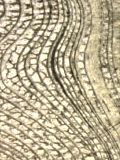 Abstract: The rudist fauna collected in western Tibet in the Aksai Chin area by the De Filippi expedition in 1914 has been reprised and
redescribed. This fauna is composed of Radiolites cf. lusitanicus, Radiolites sp., Gorjanovicia cf. endrissi,
? Sauvagesia sp., Sphaerulites sp., Durania sp., and Gyropleura sp. The rudist-bearing beds belong to the Tielongtan Group of the Tianshuihai
terrane. The Turonian-? Coniacian Xiloqzung Formation (Fm.) bear the older rudists (Radiolites cf. lusitanicus, Radiolites sp., Sphaerulites sp., Durania sp.),
whereas younger ages have been determined through microfossil analysis which, compared with the western Neotethys records, suggests an early-mid Campanian age. This allowed to ascribe the younger rudists of the collection (Gorjanovicia cf. endrissi,
? Sauvagesia sp., Gyropleura sp., Radiolites sp.) to the Dongloqzung Formation. Our data confirm that rudist-bearing facies in the Tielongtan Group extend at least up to the middle Campanian. The Aksai Chin rudist assemblage should belong to the Southwestern Asian assemblage of the Eastern Mediterranean
Subprovince. Abstract: The rudist fauna collected in western Tibet in the Aksai Chin area by the De Filippi expedition in 1914 has been reprised and
redescribed. This fauna is composed of Radiolites cf. lusitanicus, Radiolites sp., Gorjanovicia cf. endrissi,
? Sauvagesia sp., Sphaerulites sp., Durania sp., and Gyropleura sp. The rudist-bearing beds belong to the Tielongtan Group of the Tianshuihai
terrane. The Turonian-? Coniacian Xiloqzung Formation (Fm.) bear the older rudists (Radiolites cf. lusitanicus, Radiolites sp., Sphaerulites sp., Durania sp.),
whereas younger ages have been determined through microfossil analysis which, compared with the western Neotethys records, suggests an early-mid Campanian age. This allowed to ascribe the younger rudists of the collection (Gorjanovicia cf. endrissi,
? Sauvagesia sp., Gyropleura sp., Radiolites sp.) to the Dongloqzung Formation. Our data confirm that rudist-bearing facies in the Tielongtan Group extend at least up to the middle Campanian. The Aksai Chin rudist assemblage should belong to the Southwestern Asian assemblage of the Eastern Mediterranean
Subprovince.
|
|
Carnets Geol., vol. 20, no. 13, p. 249-272
Online since September 21, 2020
|
|
Moldavite finds in Middle Miocene (Langhian Stage) deposits of southwestern Poland
Tomasz BRACHANIEC
| HTML  | PDF
| PDF  [510 KB]
| DOI: 10.2110/carnets.2020.2012 [510 KB]
| DOI: 10.2110/carnets.2020.2012
|
|
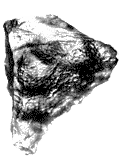 Abstract: Most of the Ries tektites (moldavites) were deposited in sediments
clearly postdating the Ries crater formation. This suggests secondary deposition
for these ejected glasses. Only a few sedimentary formations known to contain
these tektites are of Middle Miocene age and coeval with the Ries event. One is
the Poznańska Formation, which is exposed across southwestern Poland. These
mud deposits formed in the Middle Miocene (Langhian Stage). New moldavites,
described in this report were found in the Poznańska Formation and weigh
from 0.851 to 0.907 g. The North Stanisław sandpit, where the tektite
specimens were found, is located 490 km from the Ries structure. These
finds agree with the numerical simulation modelling of the ejection of these
moldavites up to 600 km away from the source crater. Abstract: Most of the Ries tektites (moldavites) were deposited in sediments
clearly postdating the Ries crater formation. This suggests secondary deposition
for these ejected glasses. Only a few sedimentary formations known to contain
these tektites are of Middle Miocene age and coeval with the Ries event. One is
the Poznańska Formation, which is exposed across southwestern Poland. These
mud deposits formed in the Middle Miocene (Langhian Stage). New moldavites,
described in this report were found in the Poznańska Formation and weigh
from 0.851 to 0.907 g. The North Stanisław sandpit, where the tektite
specimens were found, is located 490 km from the Ries structure. These
finds agree with the numerical simulation modelling of the ejection of these
moldavites up to 600 km away from the source crater.
|
|
Carnets Geol., vol. 20, no. 12, p. 241-247
Online since June 30, 2020
|
|
Chamberlainium pentagonum (Conti) comb. nov. and Spongites fruticulosus (Corallinales, Rhodophyta) in the Miocene carbonates of the western Mediterranean
Giovanni COLETTI, Juraj HRABOVSKÝ & Daniela BASSO
| HTML  | PDF
| PDF  [1,526 KB]
| DOI: 10.4267/2042/70837 [1,526 KB]
| DOI: 10.4267/2042/70837
|
|
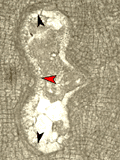 Abstract: Molecular phylogenetic
analyses discovered an unexpected biodiversity of coralline algae in modern oceans. This species richness is unlikely to be an exclusive characteristic of recent
ecosystems. With the aim to investigate fossil coralline biodiversity, a large dataset of western Mediterranean Miocene specimens, previously identified as
Spongites fruticulosus (and synonymized taxa), have been revised based on the current taxonomic framework. The analysis recognized two distinct groups. The first
group includes the specimens fitting within the current description of S. fruticulosus. The second group consists of Chamberlainium pentagonum comb.
nov., the first fossil representative of the genus. This species has been separated from S. fruticulosus on the basis of its smaller conceptacles and its thinner
conceptacle roof. The very same characters have been highlighted by modern molecular phylogenetic analyses for separating Chamberlainium from Spongites.
Chamberlainium pentagonum, similarly to the fossil specimens of Spongites fruticulosus, occurs in most of the investigated area and the two species coexist
in several localities, indicating a similar and broad ecological tolerance for both taxa. These results suggest that Miocene coralline algal biodiversity is probably underestimated
and prove the convenience of using large datasets for the study of fossil coralline algae. Abstract: Molecular phylogenetic
analyses discovered an unexpected biodiversity of coralline algae in modern oceans. This species richness is unlikely to be an exclusive characteristic of recent
ecosystems. With the aim to investigate fossil coralline biodiversity, a large dataset of western Mediterranean Miocene specimens, previously identified as
Spongites fruticulosus (and synonymized taxa), have been revised based on the current taxonomic framework. The analysis recognized two distinct groups. The first
group includes the specimens fitting within the current description of S. fruticulosus. The second group consists of Chamberlainium pentagonum comb.
nov., the first fossil representative of the genus. This species has been separated from S. fruticulosus on the basis of its smaller conceptacles and its thinner
conceptacle roof. The very same characters have been highlighted by modern molecular phylogenetic analyses for separating Chamberlainium from Spongites.
Chamberlainium pentagonum, similarly to the fossil specimens of Spongites fruticulosus, occurs in most of the investigated area and the two species coexist
in several localities, indicating a similar and broad ecological tolerance for both taxa. These results suggest that Miocene coralline algal biodiversity is probably underestimated
and prove the convenience of using large datasets for the study of fossil coralline algae.
|
|
Carnets Geol., vol. 20, no. 11, p. 223-240
Online since May 30, 2020
|
|
First occurrence of the problematic vetulicolian Skeemella clavula in the Cambrian Marjum Formation of Utah, USA
Julien KIMMIG, Wade W. LEIBACH & Bruce S. LIEBERMAN
| HTML  | PDF
| PDF  [798 KB]
| DOI: 10.4267/2042/70836 [798 KB]
| DOI: 10.4267/2042/70836
|
|
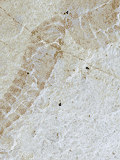 Abstract: The Cambrian Marjum
Formation of western Utah (USA) preserves a diverse soft-bodied fauna from the
upper Drumian that is slightly younger than the well-known Burgess Shale. While
the Marjum is dominated by arthropods, animals belonging to a variety of phyla
have been found. Here, we document the second occurrence of the rare, enigmatic
taxon Skeemella clavula, which was previously thought to be restricted to
the Pierson Cove Formation of the Drum Mountains. The occurrence in the Marjum
represents a new preservational setting, as well as a slightly younger deposit.
The new specimens also expand the number of known specimens to three. In
addition, they improve understanding of the morphology of this representative of
the problematic phylum Vetulicolia. Abstract: The Cambrian Marjum
Formation of western Utah (USA) preserves a diverse soft-bodied fauna from the
upper Drumian that is slightly younger than the well-known Burgess Shale. While
the Marjum is dominated by arthropods, animals belonging to a variety of phyla
have been found. Here, we document the second occurrence of the rare, enigmatic
taxon Skeemella clavula, which was previously thought to be restricted to
the Pierson Cove Formation of the Drum Mountains. The occurrence in the Marjum
represents a new preservational setting, as well as a slightly younger deposit.
The new specimens also expand the number of known specimens to three. In
addition, they improve understanding of the morphology of this representative of
the problematic phylum Vetulicolia.
|
|
Carnets Geol., vol. 20, no. 10, p. 215-221
Online since May 30, 2020
|
|
Metacuvillierinella sireli n. sp., a Campanian Rhapydioninidae (Foraminifera), from southeast Turkey. New considerations on the endoskeleton and particularities of the family, with a specialized lexicon
Jean-Jacques FLEURY & Recep ÖZKAN
| HTML  | PDF
| PDF  [4,532 KB]
| DOI: 10.4267/2042/70793 [4,532 KB]
| DOI: 10.4267/2042/70793
|
|
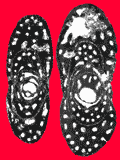 Abstract: The family Rhapydioninidae is a part of the superfamily Alveolinacea. The main
characteristic of this superfamily is its endoskeleton with each chamber
divided into tubular chamberlets,
fundamentally parallel to the coiling direction, and only connected in an
undivided space located in the anterior part of the chamber: The preseptal space. The
family Rhapydioninidae is distinguished by the coexistence of two sets of
chamberlets: Primary chamberlets, which are isolated by partitions ("cloisonnettes"),
forming a unique layer at the chamber periphery, and secondary chamberlets pierced in a more or less compact mass, the
central endoskeleton (by no way homologous of the "couche basale", sometimes
called flosculinisation or columella in some Alveolinidae). Two particular
modes of organization of the secondary chamberlets occur, the Basal
Secondary Chamberlets-Scattered
Secondary Chamberlets structure
(BSC-SSC) and the Confluent
structure; they constitute
supplementary features that distinguish this family from other groups. Abstract: The family Rhapydioninidae is a part of the superfamily Alveolinacea. The main
characteristic of this superfamily is its endoskeleton with each chamber
divided into tubular chamberlets,
fundamentally parallel to the coiling direction, and only connected in an
undivided space located in the anterior part of the chamber: The preseptal space. The
family Rhapydioninidae is distinguished by the coexistence of two sets of
chamberlets: Primary chamberlets, which are isolated by partitions ("cloisonnettes"),
forming a unique layer at the chamber periphery, and secondary chamberlets pierced in a more or less compact mass, the
central endoskeleton (by no way homologous of the "couche basale", sometimes
called flosculinisation or columella in some Alveolinidae). Two particular
modes of organization of the secondary chamberlets occur, the Basal
Secondary Chamberlets-Scattered
Secondary Chamberlets structure
(BSC-SSC) and the Confluent
structure; they constitute
supplementary features that distinguish this family from other groups.
The BSC-SSC
structure (a new name for a previously well-known organization of
chamberlets in the genus Pseudochubbina
and Cuvillierinella salentina) is the object of a large inventory
undertaken among the known taxa of the Rhapydioninidae. It leads to the
observation that this particular endoskeleton is found in the various
subfamilies on both sides of the Atlantic and cannot be used as a feature of
taxonomic significance within the group. However, it is not observed in
apparently "primitive" taxa equipped with chamberlets of large
isodiametric diameter which display a "fishnet" appearance. The confluent structure is a new name for the helicoidal structure,
which is also widespread within the family.
Metacuvillierinella sireli n. sp.,
of Campanian age, is described from outcrop and subsurface limestones in
southeast Anatolia, Turkey. The new taxon is a Rhapydioninidae based on its
test architecture and endoskeleton. As a species, it is clearly distinct
because of its initial planispiral coiling of A generation tests, its both
pseudoplanispiral generations with an advolute final stage and its thin
chamberlets showing an obvious BSC-SSC structure. The generic attribution
appears more uncertain: The faint dimorphism between generations and the
persisting pseudoplanispiral-advolute final stage are only known in the genus Metacuvillierinella.
But M. decastroi, the type species,
displays a small proloculus in the A forms, a miliolid juvenile stage, and an
endoskeleton of "fishnet" appearance (cryptic BSC-SSC structure), which
give it a particular character, appearing as being "primitive". This
contrasts with the relatively large proloculus in the A forms,
pseudoplanispiral coiling and the obvious BSC-SSC structure of the new taxon.
Thus, all these features being subjected to evolution, the faint generational
differences and the pseudoplanispiral-advolute coiling seem sufficient to
suggest the affinities between the two taxa. The new taxon is, nevertheless,
clearly more "advanced", which could be interpreted as a clue for a higher
standing, possibly compatible with a new genus. This is not undertaken here,
in consideration of the unknown "radiance" (small variations in several
well-disseminated populations and/or other species of the same kind) of the
new taxon with the present state of knowledge.
Additionally, with a review of the BSC-SSC structure, the various genera of the family
Rhapydioninidae are revisited, namely Pseudochubbina,
Cuvillierinella, Murciella, Sigalveolina, Cyclopseudedomia, Sellialveolina,
Rhapydionina, Fanrhapydionina, Chubbina, Praechubbina, Raadshoovenia,
Neomurciella, Twaraina; special attention is reserved to the Euro-Asiatic
genus Pseudedomia, of which the
original material and, consequently, the consecutive interpretative
identifications, appear doubtful. New sections of Subalveolina dordonica and Fleuryana
adriatica are figured.
The conclusion deals mainly with the criteria used for distinguishing various
systematic levels within the family. The classical differentiation between "specific" and "generic"
characters, if eventually convenient for simple or inadequately known groups, seems
unsuited for a complex and well known family like this one.
A more pragmatic mode of working is proposed,
using any character as a simple element without any meaning by itself, but to
be understood and interpreted among the others, that is to say in the
evolutionary perspective of the whole group.
A lexicon of the used terms in Rhapydioninidae and closely related taxa in given in an appendix.
|
|
Carnets Geol., vol. 20, no. 9, p. 165-213
Online since May 11, 2020
|
|
Nomenclature note, p. 214
|
|
Impact of the Anoxic Oceanic Event II on the evolution of ostracods in the Cenomanian-Turonian deposits of the Tinrhert Basin (SE Algeria)
Soumia TCHENAR, Bruno FERRÉ, Mohammed ADACI, Djamila ZAOUI, Madani BENYOUCEF, Mustapha BENSALAH & Touria KENTRI
| HTML  | PDF
| PDF  [1,382 KB]
| DOI: 10.4267/2042/70792 [1,382 KB]
| DOI: 10.4267/2042/70792
|
|
 Abstract: Around the Cenomanian/Turonian
boundary in the Tinrhert Basin, ostracods are seldom found in most of the
sampled levels. The assemblages show no specific diversity, their frequency not
exceeding 4% of the whole microfauna. Their 'climactic' presence, both
qualitatively and quantitatively, is observed at the base of the lower Turonian,
where ostracod assemblages are dominated by the genera Cythereis, Paracypris,
and Cytherella. Abstract: Around the Cenomanian/Turonian
boundary in the Tinrhert Basin, ostracods are seldom found in most of the
sampled levels. The assemblages show no specific diversity, their frequency not
exceeding 4% of the whole microfauna. Their 'climactic' presence, both
qualitatively and quantitatively, is observed at the base of the lower Turonian,
where ostracod assemblages are dominated by the genera Cythereis, Paracypris,
and Cytherella.
In order to interpret this data, we document a paleoecological study supported
by evidence compiled from five geological sections, dealing with the respective
impact of sedimentological conditions (quartz, gypsum and pyrite), and sea-level fluctuations.
|
|
Carnets Geol., vol. 20, no. 8, p. 145-164
Online since May 11, 2020
|
|
A report on the 12th International Symposium on Fossil Algae (Lucknow, India - September 16-18, 2019)
Daniela BASSO, Arindam CHAKRABORTY & Amit K. GHOSH
| HTML  | PDF
| PDF  [2,175 KB] [2,175 KB]
|
|
Carnets Geol., vol. 20, Meeting Review 1, p. 141-144
Online since May 11, 2020
|
|
New occurrences of Modulidae (Mollusca: Gastropoda) from European Eocene, Oligocene and Miocene deposits: Data from 19th century collections
Pierre LOZOUET, Bruno CAHUZAC & Laurent CHARLES
| HTML  | PDF
| PDF  [1,285 KB]
| DOI: 10.4267/2042/70761 [1,285 KB]
| DOI: 10.4267/2042/70761
|
|
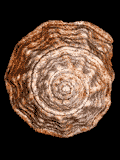 Abstract: A re-examination of the historical collections
deposited at the Bordeaux Museum of Natural History and the Faculty of Sciences
of the University of Bordeaux made it possible to identify new taxa of Modulidae in the Oligocene and Miocene of the Aquitaine Basin.
These Modulidae belong to the American groups Modulus
modulus and Trochomodulus. In
addition, three new species are described: Modulus
benoisti sp. nov. (Serravallian), Trochomodulus
stampinicus sp. nov. (Rupelian),
which is close to Trochomodulus
sublaevigatus (Orbigny, 1852), a Chattian species, and Incisilabium
trochiformis sp. nov. (Priabonian).
The latter is the oldest known Modulidae, together with Incisilabium
parisiensis (Deshayes, 1832) (Middle
Eocene) that was previously classified in the Trochidae. These results show
that the paleobiogeography and origin of the family Modulidae need to be
reconsidered. Abstract: A re-examination of the historical collections
deposited at the Bordeaux Museum of Natural History and the Faculty of Sciences
of the University of Bordeaux made it possible to identify new taxa of Modulidae in the Oligocene and Miocene of the Aquitaine Basin.
These Modulidae belong to the American groups Modulus
modulus and Trochomodulus. In
addition, three new species are described: Modulus
benoisti sp. nov. (Serravallian), Trochomodulus
stampinicus sp. nov. (Rupelian),
which is close to Trochomodulus
sublaevigatus (Orbigny, 1852), a Chattian species, and Incisilabium
trochiformis sp. nov. (Priabonian).
The latter is the oldest known Modulidae, together with Incisilabium
parisiensis (Deshayes, 1832) (Middle
Eocene) that was previously classified in the Trochidae. These results show
that the paleobiogeography and origin of the family Modulidae need to be
reconsidered.
|
|
Carnets Geol., vol. 20, no. 7, p. 125-139
Online since March 17, 2020
|
|
Nomenclature note, p. 140
|
|
Full restoration of marine conditions after the late Messinian Mediterranean Lago-Mare phase in Licodia Eubea and Villafranca Tirrena areas (east Sicily)
Francesco SCIUTO & Angela BALDANZA
| HTML  | PDF
| PDF  [691 KB]
| DOI: 10.4267/2042/70760 [691 KB]
| DOI: 10.4267/2042/70760
|
|
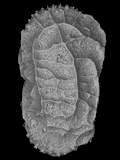 Abstract: After the Upper Messinian Mediterranean Lago-Mare phase, at the
end of the Messinian salinity crisis, the Mediterranean basin was characterized by a
return to normal marine conditions starting with the Lower Pliocene (Zanclean).
In this period, remarkably thick layers of calcareous pelitic sediments, very rich
in planktonic foraminifers and nannofossils, were widely deposited in the Mediterranean
basin. The calcareous pelitic deposits of Sicily (Trubi Formation), as well as in other
Mediterranean regions, were deposited conformably on the pre-Pliocene substrate, which
is mainly represented by Messinian evaporites or by the post-evaporitic Lago-Mare
facies. We have analysed samples taken from the lower portion of the Trubi Formation
(Zanclean), just above the Messinian facies, collected from Licodia Eubea and
Villafranca Tirrena areas (eastern Sicily). Micropalaentological assemblages consist of
benthic and planktonic foraminifers and a typical deep-water ostracod fauna. The
microfossil association and the stratigraphy of the Messinian-Pliocene transitional
layers, supported by calcareous nannoplankton data, demonstrate not only rapid sea-level rise in this sector of the Mediterranean region, but also that this event,
occurred without producing erosional features, unlike at other sites (e.g.,
Strait of Gibraltar). Abstract: After the Upper Messinian Mediterranean Lago-Mare phase, at the
end of the Messinian salinity crisis, the Mediterranean basin was characterized by a
return to normal marine conditions starting with the Lower Pliocene (Zanclean).
In this period, remarkably thick layers of calcareous pelitic sediments, very rich
in planktonic foraminifers and nannofossils, were widely deposited in the Mediterranean
basin. The calcareous pelitic deposits of Sicily (Trubi Formation), as well as in other
Mediterranean regions, were deposited conformably on the pre-Pliocene substrate, which
is mainly represented by Messinian evaporites or by the post-evaporitic Lago-Mare
facies. We have analysed samples taken from the lower portion of the Trubi Formation
(Zanclean), just above the Messinian facies, collected from Licodia Eubea and
Villafranca Tirrena areas (eastern Sicily). Micropalaentological assemblages consist of
benthic and planktonic foraminifers and a typical deep-water ostracod fauna. The
microfossil association and the stratigraphy of the Messinian-Pliocene transitional
layers, supported by calcareous nannoplankton data, demonstrate not only rapid sea-level rise in this sector of the Mediterranean region, but also that this event,
occurred without producing erosional features, unlike at other sites (e.g.,
Strait of Gibraltar).
|
|
Carnets Geol., vol. 20, no. 6, p. 107-123
Online since March 17, 2020
|
|
A rhinopristiform sawfish (genus Pristis) from the middle Eocene (Lutetian) of southern Peru and its regional implications
Alberto COLLARETA, Luz TEJADA-MEDINA, César CHACALTANA-BUDIEL, Walter LANDINI, Alí ALTAMIRANO-SIERRA, Mario URBINA-SCHMITT & Giovanni BIANUCCI
| HTML  | PDF
| PDF  [1,180 KB]
| DOI: 10.4267/2042/70759 [1,180 KB]
| DOI: 10.4267/2042/70759
|
|
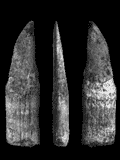 Abstract: Modern sawfishes (Rhinopristiformes: Pristidae) are circumglobally distributed in warm waters and
are common in proximal marine and even freshwater habitats. The fossil record of
modern pristid genera (i.e., Pristis and Anoxypristis) dates back to the early Eocene and is mostly represented by isolated
rostral spines and oral teeth, with phosphatised rostra representing exceptional
occurrences. Here, we report on a partial pristid rostrum, exhibiting several
articulated rostral spines, from middle Eocene strata of the Paracas Formation (Yumaque Member) exposed in the southern Peruvian East Pisco Basin. This finely
preserved specimen shows anatomical structures that are unlikely to leave a
fossil record, e.g., the paracentral grooves that extend along the ventral surface of the
rostrum. Based on the morphology of the rostral spines, this fossil sawfish is
here identified as belonging to Pristis. To our knowledge, this discovery represents the geologically oldest known
occurrence of Pristidae from the Pacific Coast of South America. Although the
fossil record of pristids from the East Pisco Basin spans from the middle Eocene
to the late Miocene, sawfishes are no longer present in the modern cool,
upwelling-influenced coastal waters of southern Peru. Given the ecological
preferences of the extant members of Pristis, the occurrence of this genus in the Paracas deposits suggests that
middle Eocene nearshore waters in southern Peru were warmer than today. The
eventual disappearance of pristids from the coastal waters off southern Peru
might be interpreted as reflecting the late Cenozoic trend of strengthening of
the Humboldt Current. Abstract: Modern sawfishes (Rhinopristiformes: Pristidae) are circumglobally distributed in warm waters and
are common in proximal marine and even freshwater habitats. The fossil record of
modern pristid genera (i.e., Pristis and Anoxypristis) dates back to the early Eocene and is mostly represented by isolated
rostral spines and oral teeth, with phosphatised rostra representing exceptional
occurrences. Here, we report on a partial pristid rostrum, exhibiting several
articulated rostral spines, from middle Eocene strata of the Paracas Formation (Yumaque Member) exposed in the southern Peruvian East Pisco Basin. This finely
preserved specimen shows anatomical structures that are unlikely to leave a
fossil record, e.g., the paracentral grooves that extend along the ventral surface of the
rostrum. Based on the morphology of the rostral spines, this fossil sawfish is
here identified as belonging to Pristis. To our knowledge, this discovery represents the geologically oldest known
occurrence of Pristidae from the Pacific Coast of South America. Although the
fossil record of pristids from the East Pisco Basin spans from the middle Eocene
to the late Miocene, sawfishes are no longer present in the modern cool,
upwelling-influenced coastal waters of southern Peru. Given the ecological
preferences of the extant members of Pristis, the occurrence of this genus in the Paracas deposits suggests that
middle Eocene nearshore waters in southern Peru were warmer than today. The
eventual disappearance of pristids from the coastal waters off southern Peru
might be interpreted as reflecting the late Cenozoic trend of strengthening of
the Humboldt Current.
|
|
Carnets Geol., vol. 20, no. 5, p. 91-105
Online since March 17, 2020
|
|
Identification of a Romaniceras (Romaniceras) marigniacum sp. nov. ammonite biohorizon (Middle Turonian) at the base of the Tuffeau Jaune de Touraine (France)
Francis AMÉDRO, Francis ROBASZYNSKI, Hervé CHÂTELIER, Patrice FERCHAUD & Bertrand MATRION
| HTML  | PDF
| PDF  [3,838 KB]
| DOI: 10.4267/2042/70720 [3,838 KB]
| DOI: 10.4267/2042/70720
|
|
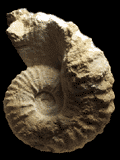 Abstract:
In the south of the Paris Basin, along the Loire and
Cher valleys, the Tuffeau Jaune de Touraine Formation was traditionally
attributed to the Late Turonian by the presence of rare Romaniceras
deverianum (Orbigny, 1841). Moreover, the several metres of tempestites at the base of the
formation never yielded ammonites. Today, in southern Touraine, more than 150
ammonites were collected from the base of the Tuffeau Jaune de Touraine and in
the highest part of the underlying Tuffeau de Bourré bring new significant
data: the lower part of the Tuffeau Jaune de Touraine remain in the Romaniceras
ornatissimum zone,
Middle Turonian in age (Tm 3). Furthermore, the discovery in that biohorizon of
the new species Romaniceras (R.) marigniacum Amédro & Châtelier sp.
nov. is indicative of the highest part of
the R. ornatissimum zone (high Tm3). Other species are associated to the R. marigniacum biohorizon as: Romaniceras
(Yubariceras) ornatissimum (Stoliczka, 1864), Masiaposites cf. kennedyi Amédro & Devalque, 2014, Collignoniceras
woollgari regulare (Haas, 1946), C. turoniense (Sornay,
1951) and Collignoniceras
vigennum Amédro & Châtelier
sp. nov. Abstract:
In the south of the Paris Basin, along the Loire and
Cher valleys, the Tuffeau Jaune de Touraine Formation was traditionally
attributed to the Late Turonian by the presence of rare Romaniceras
deverianum (Orbigny, 1841). Moreover, the several metres of tempestites at the base of the
formation never yielded ammonites. Today, in southern Touraine, more than 150
ammonites were collected from the base of the Tuffeau Jaune de Touraine and in
the highest part of the underlying Tuffeau de Bourré bring new significant
data: the lower part of the Tuffeau Jaune de Touraine remain in the Romaniceras
ornatissimum zone,
Middle Turonian in age (Tm 3). Furthermore, the discovery in that biohorizon of
the new species Romaniceras (R.) marigniacum Amédro & Châtelier sp.
nov. is indicative of the highest part of
the R. ornatissimum zone (high Tm3). Other species are associated to the R. marigniacum biohorizon as: Romaniceras
(Yubariceras) ornatissimum (Stoliczka, 1864), Masiaposites cf. kennedyi Amédro & Devalque, 2014, Collignoniceras
woollgari regulare (Haas, 1946), C. turoniense (Sornay,
1951) and Collignoniceras
vigennum Amédro & Châtelier
sp. nov.
With regard to the top of
the Tuffeau de Bourré Formation, it yielded about fifty specimens of ammonites
but the assemblage is different to that found in the type locality of Bourré-Montrichard
in the Cher valley. The material collected near the Vienne and Creuse junction
includes : Lewesiceras
peramplum (Mantell, 1822), Romaniceras (Y.) ornatissimum (Stoliczka,
1864),
Collignoniceras woollgari regulare (Haas, 1946), C. canthus (Orbigny,
1856) and C. turoniense (Sornay, 1951). The species Collignoniceras
papale (Orbigny, 1841), which represents one third of the Bourré collection is apparently
absent whereas three new species belonging to the same genus are identified as : C. hourqueigi Amédro & Châtelier sp.
nov., C. badilleti Amédro & Châtelier
sp. nov. and Collignoniceras sp. A.
|
|
Carnets Geol., vol. 20, no. 4, p. 37-89
Online since February 22, 2020
|
|
Nomenclature note, p. 90
|
|
A new Cassiduloid (Echinodermata, Echinoidea) in the Albian of the Sergipe-Alagoas basin, Brazil
Cynthia L. de C. MANSO
| HTML  | PDF
| PDF  [410 KB]
| DOI: 10.4267/2042/70719 [410 KB]
| DOI: 10.4267/2042/70719
|
|
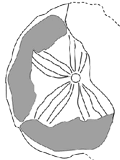 Abstract: This paper presents a new discovery of the echinoid
species Phyllobrissus humilis (Gauthier, 1875) from the Albian age Riachuelo Formation of the Sergipe-Alagoas Basin. The
only specimen obtained in the Maruim 1 outcrop expresses the main species
characteristics. Paleoecological notes and a dichotomous key are presented to
facilitate the identification of the cassiduloid species from the Cretaceous of
Sergipe-Alagoas Basin. Abstract: This paper presents a new discovery of the echinoid
species Phyllobrissus humilis (Gauthier, 1875) from the Albian age Riachuelo Formation of the Sergipe-Alagoas Basin. The
only specimen obtained in the Maruim 1 outcrop expresses the main species
characteristics. Paleoecological notes and a dichotomous key are presented to
facilitate the identification of the cassiduloid species from the Cretaceous of
Sergipe-Alagoas Basin.
|
|
Carnets Geol., vol. 20, no. 3, p. 29-35
Online since February 22, 2020
|
|
The shark-toothed dolphin Squalodon (Cetacea: Odontoceti) from the remarkable Montagna della Majella marine vertebrate assemblage (Bolognano Formation, central Italy)
Alberto COLLARETA, Andrea DI CENCIO, Renato RICCI & Giovanni BIANUCCI
| HTML  | PDF
| PDF  [847 KB]
| DOI: 10.4267/2042/70716 [847 KB]
| DOI: 10.4267/2042/70716
|
|
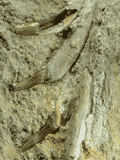 Abstract: The extinct
family Squalodontidae consists of heterodont, medium-sized odontocetes, featuring a long rostrum that houses large, procumbent incisors and
heavily ornamented postcanine teeth carrying accessory denticles, hence their
vernacular name, "shark-toothed dolphins". These longirostrine toothed
whales are often seen as bridging the anatomical gap between archaic Oligocene
odontocetes and their late Miocene to Holocene relatives. Possibly among the
major marine predators of their time, the shark-toothed dolphins are
important components of several lower Miocene marine-mammal assemblages from the
North Atlantic and Mediterranean/Paratethysian realms. In the present work, a
partial skull of Squalodontidae is described from the strata of the Bolognano
Formation cropping out in the northeastern sector of the Montagna della Majella
massif (Abruzzo, central Italy), which has previously yielded a rich lower
Miocene marine-vertebrate assemblage, including eleven taxa of elasmobranchs as
well as subordinate teleosts and very
fragmentary remains of marine reptiles and mammals. The specimen consists of the
anterodorsal portion of a rostrum, preserving parts of both premaxillae and left
maxilla, and the anteriormost seven upper left teeth. This partial skull is here
identified as belonging to the genus Squalodon, whose presence in the Montagna
della Majella vertebrate assemblage had already been tentatively proposed on the
basis of two fragmentary teeth. The paleontological significance of this find is
discussed in the broader framework of the Euromediterranean record of Squalodon. Abstract: The extinct
family Squalodontidae consists of heterodont, medium-sized odontocetes, featuring a long rostrum that houses large, procumbent incisors and
heavily ornamented postcanine teeth carrying accessory denticles, hence their
vernacular name, "shark-toothed dolphins". These longirostrine toothed
whales are often seen as bridging the anatomical gap between archaic Oligocene
odontocetes and their late Miocene to Holocene relatives. Possibly among the
major marine predators of their time, the shark-toothed dolphins are
important components of several lower Miocene marine-mammal assemblages from the
North Atlantic and Mediterranean/Paratethysian realms. In the present work, a
partial skull of Squalodontidae is described from the strata of the Bolognano
Formation cropping out in the northeastern sector of the Montagna della Majella
massif (Abruzzo, central Italy), which has previously yielded a rich lower
Miocene marine-vertebrate assemblage, including eleven taxa of elasmobranchs as
well as subordinate teleosts and very
fragmentary remains of marine reptiles and mammals. The specimen consists of the
anterodorsal portion of a rostrum, preserving parts of both premaxillae and left
maxilla, and the anteriormost seven upper left teeth. This partial skull is here
identified as belonging to the genus Squalodon, whose presence in the Montagna
della Majella vertebrate assemblage had already been tentatively proposed on the
basis of two fragmentary teeth. The paleontological significance of this find is
discussed in the broader framework of the Euromediterranean record of Squalodon.
|
|
Carnets Geol., vol. 20, no. 2, p. 19-28
Online since February 22, 2020
|
|
A critical look at Tré Maroua (Le Saix, Hautes-Alpes, France), the Berriasian GSSP candidate section
Bruno R.C. GRANIER, Serge FERRY & Mohamed BENZAGGAGH
| HTML  | PDF
| PDF  [2,966 KB]
| DOI: 10.4267/2042/70714 [2,966 KB]
| DOI: 10.4267/2042/70714
|
|
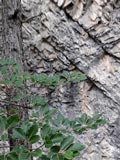 Abstract: The Tré Maroua site in SE France was recently
selected by the Berriasian Working Group (BWG) of the International
Subcommission on Cretaceous Stratigraphy (ISCS) as the candidate locality for
the reference section of the Berriasian Global Boundary Stratotype Point (GSSP).
However, on the basis of our preliminary investigation at this site and also
from field observations over a larger area, this candidate section is
paleogeographically located on a deep-water slope riddled with successive
erosional surfaces, stratigraphic hiatuses and breccias. It does not meet at
least four of the five "geological requirements for a GSSP".
Accordingly, in our opinion, its candidacy must be definitely precluded. Abstract: The Tré Maroua site in SE France was recently
selected by the Berriasian Working Group (BWG) of the International
Subcommission on Cretaceous Stratigraphy (ISCS) as the candidate locality for
the reference section of the Berriasian Global Boundary Stratotype Point (GSSP).
However, on the basis of our preliminary investigation at this site and also
from field observations over a larger area, this candidate section is
paleogeographically located on a deep-water slope riddled with successive
erosional surfaces, stratigraphic hiatuses and breccias. It does not meet at
least four of the five "geological requirements for a GSSP".
Accordingly, in our opinion, its candidacy must be definitely precluded.
|
|
Carnets Geol., vol. 20, no. 1, p. 1-17
Online since February 22, 2020
|
|
|
|